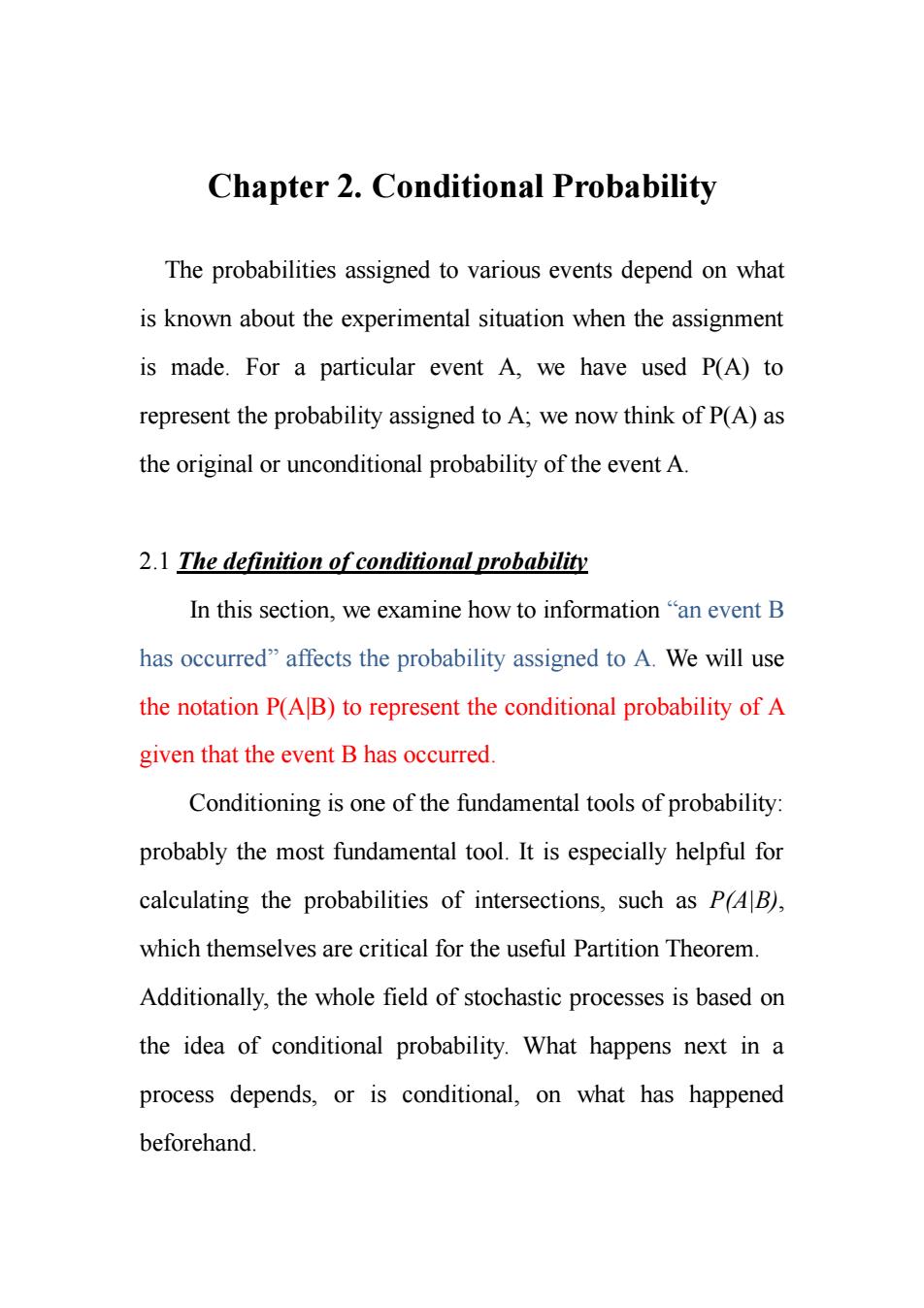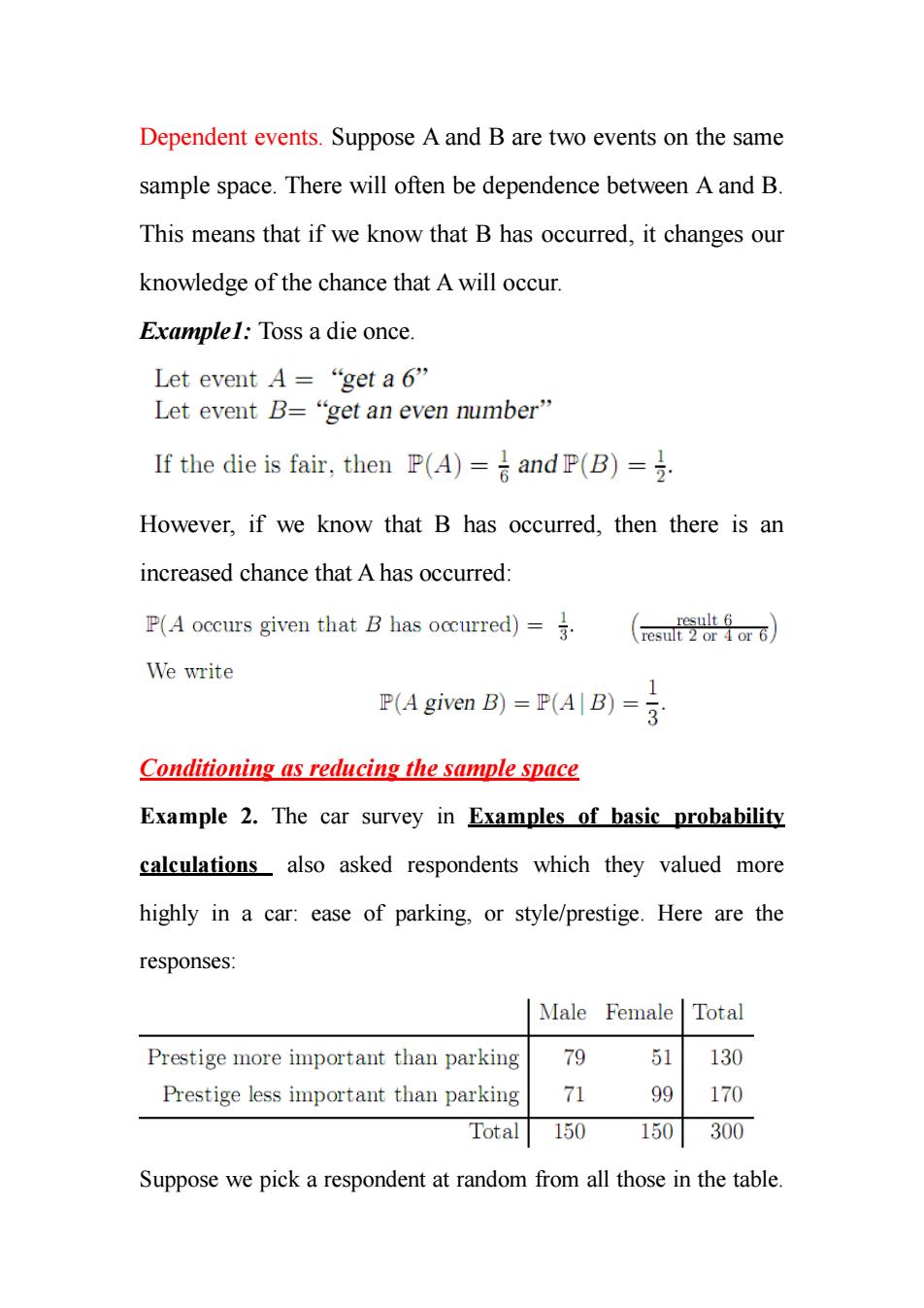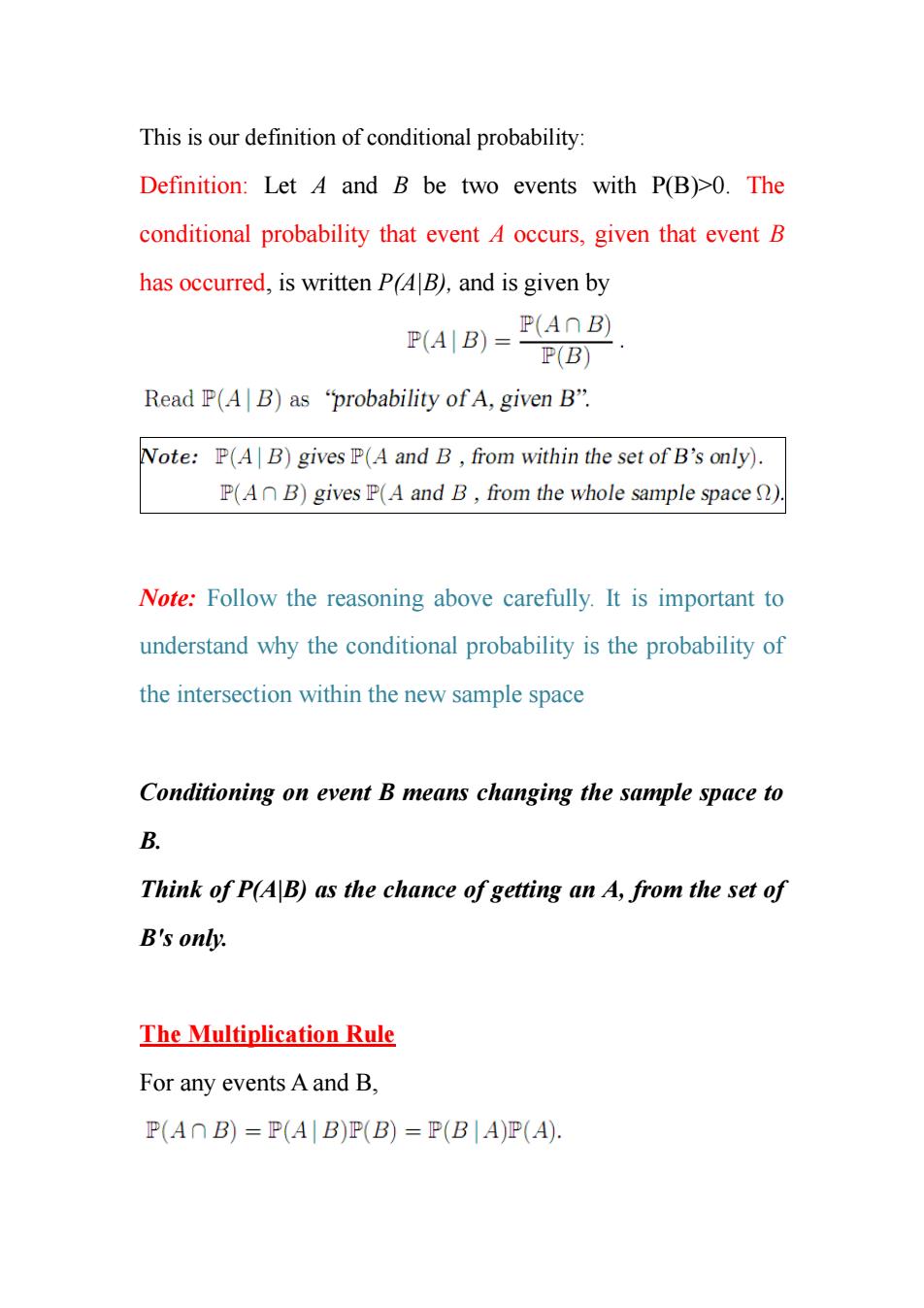
Chapter 2.Conditional Probability The probabilities assigned to various events depend on what is known about the experimental situation when the assignment is made.For a particular event A,we have used P(A)to represent the probability assigned to A;we now think of P(A)as the original or unconditional probability of the event A. 2.1 The definition of conditional probability In this section,we examine how to information"an event B has occurred"affects the probability assigned to A.We will use the notation P(AB)to represent the conditional probability of A given that the event B has occurred. Conditioning is one of the fundamental tools of probability: probably the most fundamental tool.It is especially helpful for calculating the probabilities of intersections,such as P(AB). which themselves are critical for the useful Partition Theorem. Additionally,the whole field of stochastic processes is based on the idea of conditional probability.What happens next in a process depends,or is conditional,on what has happened beforehand
Chapter 2. Conditional Probability The probabilities assigned to various events depend on what is known about the experimental situation when the assignment is made. For a particular event A, we have used P(A) to represent the probability assigned to A; we now think of P(A) as the original or unconditional probability of the event A. 2.1 The definition of conditional probability In this section, we examine how to information “an event B has occurred” affects the probability assigned to A. We will use the notation P(A|B) to represent the conditional probability of A given that the event B has occurred. Conditioning is one of the fundamental tools of probability: probably the most fundamental tool. It is especially helpful for calculating the probabilities of intersections, such as P(A|B), which themselves are critical for the useful Partition Theorem. Additionally, the whole field of stochastic processes is based on the idea of conditional probability. What happens next in a process depends, or is conditional, on what has happened beforehand

Dependent events.Suppose A and B are two events on the same sample space.There will often be dependence between A and B. This means that if we know that B has occurred,it changes our knowledge of the chance that A will occur Examplel:Toss a die once. Let event A=“geta6 Let event B=“get an even number'” If the die is fair,then P(A)=andP(B)=. However,if we know that B has occurred,then there is an increased chance that A has occurred: P(A occurs given that B has occurred)=3. (result o or We write (A given B)(A) Conditioning as reducing the sample space Example 2.The car survey in Examples of basic probability calculations also asked respondents which they valued more highly in a car:ease of parking,or style/prestige.Here are the responses: Male Female Total Prestige more important than parking 79 51 130 Prestige less important than parking 71 99 170 Total150150300 Suppose we pick a respondent at random from all those in the table
Dependent events. Suppose A and B are two events on the same sample space. There will often be dependence between A and B. This means that if we know that B has occurred, it changes our knowledge of the chance that A will occur. Example1: Toss a die once. However, if we know that B has occurred, then there is an increased chance that A has occurred: Conditioning as reducing the sample space Example 2. The car survey in Examples of basic probability calculations also asked respondents which they valued more highly in a car: ease of parking, or style/prestige. Here are the responses: Suppose we pick a respondent at random from all those in the table

Let event A="respondent thinks that prestige is more important" #A's 130 P(A)= total#respondents300 =0.43. Suppose we reduce our sample space from =fall people in table to B=fall males in table F(respondent thinks prestige is more important,given that respondent is male) males who favour prestige total males = male A's males 79 二16而 =0.53 We write: P(AB)=0.53 We could follow the same working for any pair of events,A and B: P(AB)= #B's who are A total B's = in table who are BOTH B and A #B's (#in B AND A)/(#in) (#inB)/(#in2) F(AnB) P(B)
Let event A =“respondent thinks that prestige is more important”. Suppose we reduce our sample space from

This is our definition of conditional probability: Definition:Let 4 and B be two events with P(B)>0.The conditional probability that event 4 occurs,given that event B has occurred,is written P(A B),and is given by P(A|B)= P(A0B) P(B) Read P(A B)as "probability of A,given B". Note:P(A B)gives P(A and B,from within the set of B's only). P(AnB)gives P(A and B,from the whole sample space Note:Follow the reasoning above carefully.It is important to understand why the conditional probability is the probability of the intersection within the new sample space Conditioning on event B means changing the sample space to 中 Think of P(A B)as the chance of getting an A,from the set of B's only. The Multiplication Rule For any events A and B, P(AB)=P(A B)P(B)=P(B A)P(A)
This is our definition of conditional probability: Definition: Let A and B be two events with P(B)>0. The conditional probability that event A occurs, given that event B has occurred, is written P(A|B), and is given by Note: Follow the reasoning above carefully. It is important to understand why the conditional probability is the probability of the intersection within the new sample space Conditioning on event B means changing the sample space to B. Think of P(A|B) as the chance of getting an A, from the set of B's only. The Multiplication Rule For any events A and B

New statement of the Partition Theorem The Law of Total Probability) The Multiplication Rule gives us a new statement of the Partition Theorem (Total Probability Theorem) If B,...,Bm partition S,then for any event A, F(A)=SP(AB)=>P(A B:)F(B). Both formulations of the Partition Theorem are very widely used, but especially the conditional formulation ∑1P(AB)P(B). Examples of conditional probability and partitions Example 3.A news magazine publishes three columns entitled"Art"(A). "Books"(B),and"Cinema"(C).Reading habits of a randomly selected reader with respect to these columns are Read A BCAOBAOC BOC AOBOC regularly Probability0.140.230.370.080.090.130.05 We thus have P(4IB)-P(4B)_0.08 P90230348 P4BU0=P4n8UC》_004+005+003.0255 P(BUC) 0.47 P(Alreads atr least one)-P(ALAUBUC)-(A(BC) P(AUBUC) “n40G-85-02c P(A P4U81C=P4UnC》.004+0o5+008-0459 P(C) 0.37
New statement of the Partition Theorem (The Law of Total Probability) The Multiplication Rule gives us a new statement of the Partition Theorem (Total Probability Theorem) Both formulations of the Partition Theorem are very widely used, but especially the conditional formulation Examples of conditional probability and partitions Example 3. A news magazine publishes three columns entitled “Art”(A), “Books”(B), and “Cinema”(C). Reading habits of a randomly selected reader with respect to these columns are Read regularly A B C A B A C B C A B C Probability 0.14 0.23 0.37 0.08 0.09 0.13 0.05 We thus have 0.459 0.37 0.04 0.05 0.08 ( ) (( ) )) ( | ) 0.286 0.49 0.14 ( ) ( ) ( ) ( ( )) ( | ) ( | ) 0.255 0.47 0.04 0.05 0.03 ( ) ( ( )) ( | ) 0.348 0.23 0.08 ( ) ( ) ( | ) P C P A B C P A B C P A B C P A P A B C P A A B C P A reads at least one P A A B C P B C P A B C P A B C P B P A B P A B